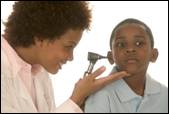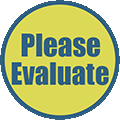Role #2: Conduct Developmental Surveillance

It is important to determine if the child is meeting developmental expectations. Developmental surveillance (i.e. screening or monitoring) should be a part of every well-child visit, regardless of age. Role 2 allows also for engaging in Role 1, as your questions serve not only to assess the child's development, but also serve to educate the parent about what the child should be doing.
The more you see children of different ages, the more you will learn about the expected development at different ages. After you see hundreds of 15-month olds, you will spot the 15-month who is not walking. After talking to hundreds of four-year olds, and recognizing the complexity of four-year old language, you will be concerned about a four-year old whose language you cannot understand well and who is only using 2-3 word sentences. But as a medical student, before you have an opportunity to see very many children, how will you know if development is appropriate? Learning how to ask the right questions and learning to use developmental screening tools will help you to better evaluate if the child is developing as expected for age.
The American Academy of Pediatrics' Policy on Developmental Surveillance and Screening (2006) recommend that developmental surveillance be incorporated at every well-child preventive care visit, then concerns be addressed with standardized screening .In addition, standardized screening should be conducted, at minimum, at the 9-, 18-, 30-month well child visits
Questions
Once you learn the questions to ask, your interview can yield rich information about development. Try to avoid questions that can be answered with 'yes/no' or 'fine.' Go here for an example
Templates
Many practices have designed their note templates (paper or electronic) in such a form that triggers you to ask about critical items.
Formal Developmental Screening Tools
In addition to the interview, there are formal developmental screening tools available for use in pediatric practices. The most common of these are the following:
Parent Report Instruments
Parents' Evaluation of Developmental Status, Ages and Stages Questionnaires, and Child Development Inventories,
Direct Observation Instruments
Early Language Milestone Scale, and Brigance Screens
For links to these tools, see again the AAP policy on developmental surveillance and screening. mentioned above
Consider all Domains
It is important to consider all the major domains of development and screen in each area:
- Motor development - fine and gross motor
- Language development - expressive (how well can the child communicate?), receptive (how well can the child understand and follow directions?) and articulation (how well can you understand what this child is saying?)
- Social development - interaction with adults and with other children
- Self-care/independence development - how well is the child able to do age appropriate skills such as dressing, brushing the teeth to, calling 911?
It is very hard to memorize developmental milestones. They often do not become meaningful until you see many children and have a sense of comparison. You don't want to inadvertently worry the parent by asking if the child is doing X, if X is way outside the range of normal. For example, you don't want to ask if the child can walk, if she is only six months old, or if she can tie her shoes if she is only three. As a student, it is best to refer to a developmental chart when asking questions associated with development.




